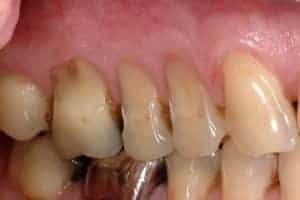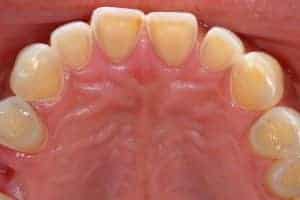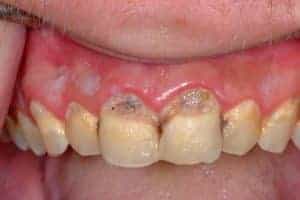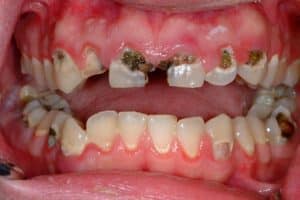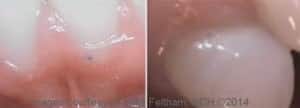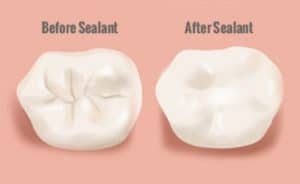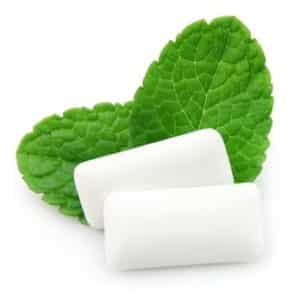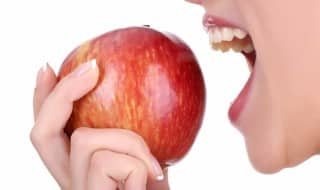
You probably don’t have to be told that acid and teeth don’t mix.
Take the acid from your stomach, for example. Anyone suffering from GERD knows that tooth wear from acid reflux is a common problem.
This patient suffers from GERD (gastric reflux disease). The sides of the teeth are eroded because stomach acid would pool in the cheeks while the patient was asleep.
Bulimics, too, have a problem with stomach acid eroding the teeth.
Acid wear caused by bulimia. The yellow areas indicate where little to no enamel is present.
But as it turns out, the foods you eat and the drinks you consume can also contain high amounts of acid, and your teeth’s enamel may be suffering because of it.
Enamel is the hard coating that covers your teeth. It’s the hardest substance in your body, but it’s not impervious to acid. In fact, acid can eat away at the enamel. Once the enamel is eroded completely, dietary acid can begin to wear away at the dentin – the substance your teeth are made of – and that’s when tooth decay and tooth death can occur.
Dr. Brusky has seen more than his fair share of acid wear in his dental practice. According to him, tooth wear as it relates to dietary acid has increased two-fold in recent years.
According to a recent study, U.S. consumers spend $10 Billion per year on acid-heavy energy drinks. The result is that 1 in 3 young adults (ages 18-35) are showing signs of tooth wear, and 25% of children are now showing cavities by age 11.
Dr. Brusky advocates prevention to keep tooth wear from affecting the enamel of your teeth. When acid is allowed to eat the enamel away, it can lead to a host of dental problems like sensitivity to hot, cold or sweet drinks; discoloration or a translucent effect; cracks, pain, and tooth decay.
The effects are typically seen on the upper front teeth, but gravity can cause the acid to linger, affecting the lower teeth over time.
It only takes four small acidic “moments” per day to put your enamel at risk.
Here are the steps Dr. Brusky advises his patients to take to keep dietary acid from causing acid wear.
Watch What You Eat
Even if you tend to eat a healthy diet, you can still find yourself prone to acid wear, says Dr. Brusky.
The worst foods for your teeth are ones that are high in carbohydrates.
As you chew carbohydrates, the saliva in your mouth turns those carbs into tooth-eroding acid. Some high-carbohydrate foods like white rice get stuck in your teeth, which extends the length of time your teeth remain at risk.
Citrus fruit and green apples, when eaten regularly with the front teeth, can also cause significant erosion.
You don’t have to be told that candy is bad for you. The combination of sugar and acid (usually citric for tartness) is particularly harmful to your enamel. Plus, candy sticks to your teeth even worse than carbs, leading to more risk of tooth decay and erosion.
Salad dressings that contain vinegar, some hot sauces, and pickles (which contain sugar and vinegar) are also foods to limit when you’re worried about tooth wear.
Eat More Teeth-Friendly Food
Eating cheese, drinking milk, black and green teas and consuming more fibrous vegetables can decrease the amount of acid left in your mouth following a meal filled with sugar or carbs.
Limit Acidic Drinks
Acid wear by high soda consumption. These two patients depicted above are only 20 years old.
Soft drinks, energy drinks, sports drinks, wine (both red and white) and fruit juices are typically through the roof in acid content, says Dr. Brusky. Believe it or not, even teas made with dried fruits are very erosive.
He adds, “You can become especially susceptible to tooth wear if you swish with these types of drinks in your mouth.
“If the drink contains carbonation, caffeine, and sugar in addition to the acid, that’s like a full-frontal assault on your pearly whites.”
Dr. Brusky recommends limiting these drinks to once a day, preferably with meals, or cut them out completely to prevent acid wear.
Drink with a Straw
If you must have a high-acid drink, try drinking it through a straw and don’t swish. The more you can bypass your teeth while you drink, the less damage your enamel will suffer.
Drink More Water
Immediately after consuming foods and drinks with a high acid content, rinse and swish with water. Doing so will dislodge any food that may have become caught in your teeth and limit any acid left behind.
Drinking more water throughout the day also increases the amount of saliva in your mouth, which works to counteract the acid.
Brush Properly
As a general rule, you should never brush your teeth immediately after consuming a high-acid meal or drink.
“At the very least, you should wait an hour before brushing your teeth,” says Dr. Brusky.
He warns that you should never over brush, either. Too much brushing or brushing too hard can cause another type of tooth wear called abrasion. There are a few pastes such as Enamelon, which is only sold through dentists, that does not contain abrasives.
“Plaque is soft and doesn’t need vigorous or hard brushing to remove it,” he says. “It’s more the technique than the abrasives that matter.”
As a final tip, Dr. Brusky advises that “If you want to be extra vigilant against tooth wear, rinse and gargle with baking soda in water or drink one of the new alkaline bottled waters to minimize acidity and keep acid wear at bay.”
If you suspect that you are suffering from dietary acid wear and wish to know more about the causes and the various treatments available to you, schedule an appointment with Dr. Brusky today to discuss your options.



